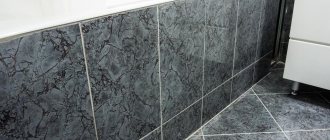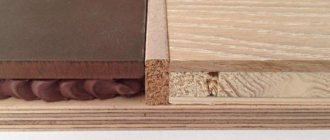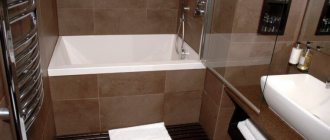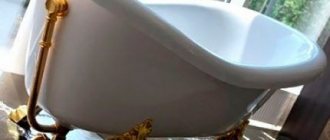A stopper, plug or plug in the bathroom (as this product is called by different users) is needed in the bathroom. Without it, it is impossible to draw a bath, soak in the fragrant foam or rinse the laundry. If for some reason this part is missing in the house, it can be replaced with improvised means or made with your own hands. Tips and recommendations from home craftsmen will help solve the problem of plugging a bathtub instead of a stopper.
Choice
Varieties
- What types of traffic jams are there??
Traditionally, this is a simple plug in the shape of a truncated cone, made of plastic, brass or rubber.
Brass plugs were used to complete cast iron bathtub fittings that were produced more than three decades ago. Nowadays they are found only in apartments of old houses, in which the plumbing has not changed during the entire period of their operation.
A metal chain (brass or stainless steel) is attached to its eye, with which you can remove the cork without getting your hands wet. However, some fittings (the so-called set of drain fittings for a bathtub) are somewhat more complicated:
- Trim - the machine allows you to open and close the drain by simply pressing it with your hand or foot;
Release of automatic strapping.
- Semi-automatic piping makes it possible to open and close the outlet from the bathtub by turning the decorative handle on the overflow.
Comparison
- Which harness is more convenient and reliable??
In terms of convenience, in my opinion, the leader is the semi-automatic harness. Automatic plugs are less convenient, if only because the drain cannot be opened without getting your hand or foot wet. This is especially inconvenient when the bathtub is full of hot or ice water.
In terms of reliability, an equally undisputed leader is a harness with a separate plug on a chain. It is reliable precisely because it is extremely simple in design. Both competing solutions have their own vulnerabilities:
- For a semi-automatic plug, this is a cable connecting it to the handle on the overflow. After some time of use (usually 2-3 years), it begins to jam;
- For an automatic plug, the cause of failure is a breakdown of its fixation mechanism. It is not sold separately from the harness, which makes the maintainability of the entire structure zero.
The price of a plastic harness with a separate plug usually does not exceed 350 - 400 rubles. Metal strapping - a semi-automatic machine will cost the buyer at least 1,500.
Inexpensive and extremely reliable design.
- Which material is better - plastic or rubber??
Rubber. It is extremely rare for a plastic plug to seal the outlet completely hermetically. In addition, the rubber plug is easy to remove from the outlet if it gets stuck, but in the case of a plastic plug, removal sometimes results in a serious problem.
Our choice is a rubber stopper.
How to open the lid on a sink? Photo
What to do? How to open the lid? I tried to hook it with something, but there were no holes.
Best answer
Summary: 1. If you can’t remove it with water, then. 2. Scoop out the water. 3. Remove the siphon. 4. Push out the plug from below. 5. Let’s look at the reason for the “wedge”. 6. Eliminate. 7. Put the siphon in place. 8. tie a “tail” to the cork to remove it. You may have to drill. 9. We use it.
Problems
- How to remove a plug from a bathtub if it is tightly stuck in the outlet?
It all depends on its material and design.
The easiest way to do this is with a rubber plug: you just need to pick it up by the edge with a flat-head screwdriver.
This also applies to a metal plug with a rubber shell.
You can try to remove the plastic plug with the same screwdriver, alternately prying it from different sides.
If this does not help, a corkscrew for wine bottles can often save the situation: it is screwed into the cork, after which it is removed with some effort. Of course, after this you will need to go to the store to get a replacement for the damaged part.
Finally, if the corkscrew turns out to be powerless, you have to take radical measures: the cork is drilled in the middle and removed with pliers.
The biggest problem that can cause the owner is a brass plug stuck in the outlet of an old bathtub. Especially if the eye for the chain, which can be caught with pliers, is broken off. Sometimes it is possible to grab its edge with a gas wrench. If the key slips, you have to disassemble the outlet and knock out the plug from below, which is extremely inconvenient due to the tightness under the bathtub.
The worst case scenario is dismantling the cast iron outlet. In this case, it is easier to change the entire harness.
As a rule, cast iron trims are equipped with brass plugs. Here are some recommendations for dismantling them:
- First, disconnect the outlet from the tubular siphon by unscrewing the union nut on the connection. This can be done with a gas wrench No. 3 - No. 4;
- Try to unscrew the outlet by inserting open pliers into its grille. If necessary, use any lever inserted between their handles;
- If the outlet does not work, heat it from below with a hair dryer or blowtorch. Thermal expansion will do its job, and the thread will move.
If the semi-automatic piping drive or the piping latch breaks down, the plug will also remain in the outlet. You can try to swing it with a plunger and pry it off with a pair of screwdrivers or knives.
- How to make a new cork with your own hands?
If for some reason you don’t feel like checking out local plumbing stores, but have a tube of silicone sealant on hand, the instructions will be quite simple:
- Glue a paper mold for casting in the shape of a truncated cone with a glued bottom, the size corresponding to the outlet grille;
- Place a rope with a loop at the end or a chain into it;
- Fill the mold with sealant. After it dries, you will receive an original and durable cork.
Any object can be cast from sealant. You just need to make a mold.
- How to plug a bathtub if there is no plug for it?
If your bathtub outlet has a stainless mesh that protects the drain from hair and other debris, place a plastic bag under it. It will ensure the release is tight, and the mesh will prevent it from floating up.
The photo shows an improvised plug made from a mesh for release and a plastic bag.
- How to replace the plug in the bathroom if a mesh or other suitable weight is not at hand?
Here are some of the most obvious solutions:
- Wrinkle a dish sponge, place it in a plastic bag and plug the outlet;
- Fill the same bag with some water, tie it and place it on the grate in the bathtub outlet;
- Cover the outlet with a plastic cup or a wet rag folded several times.
The outlet grate can be plugged with any suitable object, as long as it does not allow water to pass through.
Cleaning the drain siphon yourself
A siphon is an element designed to protect the home from the penetration of unpleasant odors from the sewer. This is ensured by the constant presence of water inside the device. This water seal also helps protect the pipes from large debris getting into them.
Siphons are classified according to their design, purpose and materials from which they are made. Structurally, the following types of these plumbing elements are distinguished:
- Bottle type. The most common are for connecting a sink to a sewer. They consist of supply pipes and a siphon settling tank, which are made in the form of a bottle. This design is characterized by high throughput, ease of operation and cleaning. Among the disadvantages, it is necessary to highlight the large overall dimensions;
- Flat. They consist of alternately interconnected pipes of different diameters. At the bottom of the device, the pipes form a kind of drop (elbow), in which a water lock is formed during operation of the device. Such a system is efficient and reliable in operation, easy to clean and perform preventive maintenance. Most often installed in the bathroom;
- Corrugated. The design resembles flat ones, but they do not consist of several pipes, but of one flexible one. This type of design is known for its versatility, but its operation can bring some inconvenience. Due to the corrugated inner surface, debris and scale accumulate in the siphon, which contributes to its rapid failure.
Siphons are used to connect toilets, bathtubs, kitchen sinks, showers and other consumers (washing machines or dishwashers) to the sewer system. According to their purpose, they can be divided into single (used exclusively for connecting one consumer) and branched. The latter is used to connect several drain pipes.
Corrosion-resistant materials are used to manufacture these elements. These are copper (brass), cast iron and plastic. Of course, there are also options made of alloy steel, but they are considered not durable enough.
Copper elements are presentable and can complement designer bathrooms. Their internal surface is absolutely smooth, which indicates the high efficiency of the siphon. But they are the most expensive; Cast iron elements were popular during Soviet times. They are durable, resistant to aggressive external influences, and are not afraid of corrosion. The most important disadvantage of such a device is the lack of flexibility - such siphons cannot be installed on non-standard connections; Plastic ones are considered universal and durable. They do not rust and can withstand temperature changes and even shock loads.
But when choosing a plastic settling element, you must definitely pay attention to the thickness of the walls and the smoothness of the inner surface. The main advantages are the affordable price and the ability to install on any plumbing fixtures.
Bathtub cleaning
It turns out that a person loses about a hundred hairs per day. And if short male hairs do not pose a threat to the sewer system, then long female hairs clog the sewer quite quickly, forcing you to disassemble the siphon several times a month, eliminating blockages.
Dismantling the siphon is an unpleasant procedure when you are in a half-bent state trying to get the contents, simultaneously brushing aside the dirty water flowing towards you. Of course, you can also use household chemicals, but they can damage the plastic parts of the siphon itself.
In this case, only mechanical cleaning remains. For example, you can use a plunger to remove a blockage. To do this, pour water into the bath, closing the hole. Then the plug is removed, and a plunger is placed in its place, which is used to make several vigorous vertical movements. The dirt will rise to the top and will be easy to remove.
The hair in the siphon is wound onto a cable and then taken out with it. The spectacle is unpleasant, but effective, since the remaining part of the blockage is easily washed down the drain with water.
However, when using a cable, there is a possibility of damaging the pipe if it is made of chrome steel, brass or plastic. Therefore, in this case, it is better to use a special “claw”, which we recommend using.
This device is inserted into the sewer siphon, then the spring on the handle should be pressed. In this case, the “claw” shrinks. If a blockage is captured, you will feel heaviness when trying to pull it out. You continue to pull and pull out the blockage that was preventing the water from draining. DIY bathtub cleaning done.
Of course, such devices can not only be ordered in China, but also found in our markets. It costs a penny. In addition, it doesn’t cost a real craftsman anything to build such a mechanism from, for example, a cocktail straw: just cut it in a spiral with scissors, and you’ll get a long spring, which can also be used to remove clogs from hair.
We recently told you why you should leave a brush under the toilet lid for 5–10 minutes. They also shared 10 amazing tips on how to clean up your home. Use our advice, and your home will delight you with impeccable cleanliness.
How do you deal with blockages in the bathroom? Share your experience.
Design
Before you get interested in how to remove a siphon from a shower stall, let’s get acquainted with its features. This element is also called a “ladder”. This product can be used to connect various plumbing fixtures. It is not used for structures with a built-in water lock and those that are connected directly to the sewer system. The following elements are suitable for shower trays: 1. Bottle (flask) trays. The functional element here is a special compartment with the shape of a bottle. These siphons are installed for high shower trays. 2. Pipe. They are assembled from several pipes of different lengths, which are connected by adapters. They are characterized by compact dimensions, therefore they are in demand for almost all shower cabins. 3. Corrugated. These are also pipe devices, but instead of hard ones, soft pipes are used that bend easily. They have a rough inner surface, which causes them to become clogged faster, which is why they are less popular. The best option for a shower stall is a pipe siphon, which has suitable characteristics and small dimensions.
How to choose the right siphon for a shower stall?
Types and features of siphons
If for some reason the drainage system does not cope with its functions, it is customary to replace the siphon. To dismantle the drain, you need to understand how to do it correctly. In some cases, it is enough to repair the drain or clear the blockage using a plumbing product. Blockages can cause your bathtub to leak.
Drain cleaning products can remove blockages and solve the issue of unhindered water flow. One of the symptoms that the cause of the leak is a blockage is the formation of an unpleasant odor from the sewer. If the use of this kind of means does not bring results, it was not possible to repair the drain, the only correct way is to replace the siphon.
Based on the materials from which this sewer equipment is made, these devices are divided into plastic and metal models. Each of them has distinctive features.
Models made of plastic are distinguished by their low price, long service life, and are not afraid of exposure to chemical elements. However, minor irregularities during the manufacturing process can lead to leakage. In addition, such spare parts are quite fragile.
For the production of metal models, copper, brass, and stainless steel are most often used. Such parts are expensive, difficult to install, get clogged quickly, but have an impressive appearance. These models are used to connect expensive bathtub models to the sewer system.
Types of siphons according to operating principle
Based on the principle of operation, there are manual, semi-automatic and automatic siphons. Let's take a closer look at each type:
- Manual siphons are characterized by simplicity of design. They consist of a thin chain or flexible cable. A lid is attached to them, which serves as a lock for the drain hole. When you need to drain the water, you just need to pull the chain, after which the lid will rise and release the drain. This system is very cheap and easy to use, but can cause some inconvenience in operation. In particular, not everyone likes to get their hands wet while uncorking the drain;
- Semi-automatic siphons consist of a more complex mechanism: a movable handle and a locking cap. The handle is connected to the lid using a flexible hidden cable. When you want to drain the water, just turn the handle, it will move the lid and the drain hole will open. When drawing water, you also need to turn the handle and plug the drain. The principle of operation allows you not to get your hands wet in water again. A siphon with such an overflow (water drainage) costs a little more than a manual one, but is considered more convenient to use;
- The automatic siphon has no competitors in terms of comfort. There are two types of this design: click-clack and with a handle. Such systems consist of a special control mechanism, a cable, a locking element and a handle. A click-clack machine consists of a flat cover connected to a cable. When pressed, it changes its position. For example, if you press twice, the shutter will open, if once, the lid will close the drain hole. The device with a handle completely replicates the design of the semi-automatic device, but is equipped with an additional protection system.
The main advantage of an automatic siphon is its “smart” operating principle. The automation can be configured so that when the pressure in the bathroom reaches a certain level, the drain hole opens and excess water flows into the sewer. This protects against flooding and problems with horizontal overflow (which, due to its diameter, often cannot handle large amounts of water). For example, click-clack siphons are also capable of closing “on their own” after the pressure reaches the permissible limit.
Types of siphons and their features
The choice of siphon is influenced by the following factors:
- Installation location;
- The amount of water that the siphon should pass through.
Bath siphons
Siphons designed for installation under the bathtub consist of two pipes - drain and overflow. In front of the siphon elbow, in which the water seal is located, both pipes are connected into one. Most models of bathtub siphons allow for adjustment, since the drain and overflow holes on different models of bathtubs may be at different distances.
Today there are bath siphons with automatic and semi-automatic drain adjustment. In the first case, to open the drain plug, you just need to press the button, in the second, you need to turn the handle located at the level of the overflow hole.
Siphons for installation under a bathtub are made of polymer materials or metal, most often copper alloys. The latter are, of course, more expensive, but if you plan to purchase an automatic drain, then it is better to take a metal piping, since the plastic ones are unreliable and often break. When purchasing a regular bathtub overflow drain, you can safely buy a plastic model; it will serve for quite a long time.
Shower siphon
The siphon, which is installed under the shower tray, must have sufficient capacity. Such siphons are often called ladders. There are drains that are mounted directly into the floor; in this case, installation of a pallet is not required.
Siphons for washbasins
Siphons for sinks are available in different modifications.
- Pipe models. This is a siphon in the form of a rigid curved pipe. For ease of cleaning, some models have a plug installed in the lowest section of the siphon.
- Corrugated models are convenient because they can be adjusted in length, which greatly facilitates installation. However, such a siphon becomes clogged with debris faster than others, since the inside of the tube is not smooth.
- Bottle siphon models have a fairly rigid design. The siphon body itself is shaped like a bottle and has a twist-off lower part, which makes cleaning easy.
- Siphon in a box. This type of siphon is used when you need to free up space under the sink. The siphon itself is installed in a hole made in the wall, and is connected to the drain hole by a thin tube.
Siphons for household appliances (dishwasher or washing machine)
As a rule, the siphons described above in a box are used for household appliances. The siphon itself is installed on the wall in a convenient place, and the drain outlet pipe is connected to it under a decorative cover.
Sometimes household appliances are connected to the sink siphon. In this case, select a model with a larger capacity and an additional pipe for connecting the drain hose.
Siphons for kitchen sinks
As a rule, bottle-type siphons are installed on the sink, since they are the most practical and fairly easy to clean. The fact is that kitchen drains may contain grease, which quickly clogs siphons, reducing their capacity.
Today, sinks with two or three compartments are often installed in the kitchen. Naturally, it will be unprofitable to install a separate siphon for each drain, so special double (or triple) siphons are used that have a common body and several outlet pipes. When installing household appliances in the kitchen that require connection to the sewer system, it is necessary to purchase siphons with additional outlets.
Replacement
Let's move on to how to change the siphon under the shower stall. It is not recommended to buy cheap products, since in order to replace a failed siphon, you will have to remove the pan. And to do this, of course, not in all cases, you have to dismantle the shower stall. Not all parts can be reused later, so you should immediately choose a reliable product that will not require frequent maintenance. No matter how reliable the equipment is, it cannot last forever. To replace the siphon, first remove the decorative panel from the bottom of the tray. It is often secured with snap-on clips. To open them, you should press the panel around the periphery with slight force. Dismantling is carried out as follows: 1. The elbow is detached from the external sewer pipe. 2. The elbow is unscrewed from the pallet, for which an adjustable wrench or washer is suitable. 3. The overflow, if any, is disconnected. 4. The drain is removed.
The next step is how to disassemble the shower siphon for cleaning. The sequence of work looks like this: 1. Place a container under the siphon into which the remaining dirty water will drain. 2. Unscrew the union nut. It is better to do this slowly so that the liquid does not get on the floor. 3. Pour out the remaining water. 4. Remove the gasket from the rubber.
Appearance of the disassembled device
Read also! Maybe
How to remove a plug from a bathroom with a modern mechanism?
Situation: there is a stopper in the bathroom, which is raised/lowered using a toggle switch (twist) under the faucet. The toggle switch (twist) stopped functioning when the plug was in the down position (plugged). It is not possible to pick up the plug. Any ideas?
Same story, traffic jam and
Same story, the cork and the wheel do not function together, so I tied a rope to the cork and usually pulled it. But today everything went a little wrong and the plug along with the rope was sucked into the drain and a vacuum was formed. I tried to pry it off with a knife, a spatula, even a pill blister - it was no use. I don't have a plunger
Thank you very much for
Thank you very much for the tips. I was so angry, I took a bath, everything was fine, but I couldn’t unscrew the plug. A small suction cup helped, it’s good that I found it in the kitchen! The cork came out like a cute little thing!
A toy with a suction cup helped!)
A toy with a suction cup helped!)
Best answers
Zverskaya:
))))))))))))))). I have the same thing and it was the same, you can lift it with a knife with a thin blade, at least it worked for me)). twist and pry at the same time...
Oksana Nikolaevna:
You'll have to manually rake it out as the thread breaks)))
Snezhana:
Have you tried it with a plunger?
125aaa:
How about calling divers?? ? Or buying a motor pump for pumping out water?
I don’t have a screwdriver at home, should I pick up a plug???
Daria Sorokina:
It was such crap. I loosened it with a plunger! . Then she turned the valve and helped me climb back in with my hand!
Artyom Rumyantsev:
Well, she didn’t get in there with the plug; the plug just wouldn’t open.
Irina:
First, scoop out the water from the bath and drain it to reduce the pressure. Then loosen, pry, etc.
Damir:
))) Scoop out the water to the bottom into the sink, using a rag or sponge to remove the remaining residue. and when it becomes free, use some thread.
rrr:
there should still be a safety drain on top to prevent excess water. Eat?…
Marina Kurilova:
All the water into the sink and then with pressure or something sharp. and for future ones there is no need to tighten the screw on this plug all the way
Hope:
It’s so good that I have a rubber stopper in my bathroom! =)
Sinister Copper:
Hmmm! ..to use such a bathroom... you need to take special courses... .And besides, this is further proof that the simpler the design, the more reliable it works....
Natalya Nikotina:
Elementary... For this operation you need an ordinary suction cup. There is another option, without a suction cup. A resourceful friend told me about him. But for this option you will have to first scoop out all the water. Turn on the vacuum cleaner, having first removed the brush and, so to speak, “suck out” the plug)))
What can you use for a bath instead of a cork?
So, you decided to take a bath and discovered that the drain plug was missing. To cope with this annoying situation, use the means at hand. So, you may find it useful:
- Plastic bag. It must be clean. You need to put a small piece of fabric in the bag. Please note that the size of the fabric should only be slightly larger than the diameter of the water drain hole. The flap must be folded several times and placed inside polyethylene. The bag should be tightly tied and placed in the drain. When you start drawing water, the improvised plug will be sucked in and the water will not flow out.
- Foil. A piece of foil needs to be folded several times and plugged into the drain.
- Cup. You will need a plastic cup as the glass product may break. The glass must be installed in the hole, placing it upside down.
- Styrofoam. You should cut a piece exactly the size of the drain.
- Sock. The fastest and easiest way. Take one or more socks, scrunch them up, and plug the drain. You can also pour a small amount of sand into a sock and wrap it in plastic.
- Sponge for washing dishes. Fold it so that it fits into the drain, then wrap it in cellophane - the plug is ready.
- Newspaper, paper sheet. The option is fast, but short-lived. You will need newspaper or sheets of paper. Fold them tightly several times and place them in the water outlet.
The click-clack mechanism in the bathroom drain broke, but they are not sold separately
In my bathroom I have a drain installed with an automatic opening and closing mechanism that is convenient for me, often called “click-clack.” Press it and it closes the drain; press it again and it opens. I can’t say that this is some kind of curiosity, but it’s not the most common type either. Apparently not everyone likes it.
I bought myself a brass waste-overflow, and that’s exactly what came with the kit. Everyone at home quickly got used to the mechanism; it did not cause any inconvenience for several years, until one day it stopped working. Neither here nor here. broken. Something bad happened just before the New Year. As I later found out, the spring burst and a fragment jammed the entire mechanism.
Drain hole with mechanism. (Source: author's photo) Drain hole with mechanism. (Source: photo by the author)
It’s good that you can unscrew the lid; it is held on by a regular screw thread. For some time I had to do without it at all, the drain hole is always open, you can’t fill the bathtub.
Looking for a spare part
It took a lot of time to find spare parts responsible for the mechanical part. I looked all over the Internet and couldn’t find it anywhere.
The most important thing is that no matter how I typed different options into the search engine, I only found the entire drain assembly, and, obviously, I don’t want to overpay. I still don’t understand why such components are not sold separately. Perhaps they can be found in the markets from knowledgeable sellers, but for the sake of this I was too lazy to go to the construction market, and there was no free time. Besides, during the New Year holidays it’s quiet for everyone.
Click-clack mechanism. (Source: photo by the author) Click-clack mechanism. (Source: photo by the author)
Desperate to find a replacement, I tried one last chance. I took a photo of the part and tried to search it using the photo. Fortunately, now search engines have such an opportunity, and that’s how I found this curiosity. Where did you find it?
The ubiquitous AliExpress
Yes, the Chinese had a lot of such spare parts, stores that sold them in abundance. Sometimes I think what would we do without them? This is not the first time I have come across the situation that something rare and less common is on AliExpress.
They probably deliver them to us, but I couldn’t find information on suppliers. Nothing to do, I had to order. Such joy costs a little over a hundred rubles, and I decided to take three pieces in reserve at once, so as not to rack my brains anymore, but to immediately change them without a long wait if it breaks again.
I placed the order a little over a year ago, and delivery lasted about a month. Now they have started shipping much faster, some parcels arrive in 10-14 days, through the Pyaterochka store. The clumsy Russian Post lost the competition in speed.
Valve mechanism. (Source: photo by the author) Mechanism with valve. (Source: photo by the author)
What and how to make a bath stopper from
You can make more than just a temporary plug with your own hands. To do this, you do not need to purchase special materials; everything you need can be found at home or in the country. What can you use?
You can use the following:
- Tree. Simple, but not very reliable material. Without special impregnation, the wood will begin to swell.
- Silicone. This is a more reliable option, since silicone is not afraid of contact with liquids.
- Rubber. The most suitable option is that the material is flexible and does not deteriorate when exposed to water. You can use regular bottle caps.
- Flip-flop. A great option is to make a plug for the drain hole from an old slipper.
- Kids toys. Toys in the shape of a small ball are suitable.
Making a drain plug:
- Wooden. Measure the diameter of the hole for draining the water, then transfer the resulting measurement to a wooden block. Carefully cut out the cylinder and sand it using sandpaper. You can make a hole in the upper part and insert a chain or any strong cord into it. To ensure that the resulting plug serves you for a long time, cover it with several layers of special hydrophilic impregnation.
- Rubber plug. To make it, you will need several wine corks, which should be fastened together. There should be no gaps between the plugs. Otherwise, the product will begin to leak liquid.
- From a slipper. A rather labor-intensive option, because you will need to carefully cut a piece of the required diameter from the shoe. After which the circle should be sanded with sandpaper.
- Children's ball. The toy must be cut into two halves, a chain and a strong cord must be inserted. Then fill the product with silicone.
- Plastic bag. Instead of a ball, you can take a clean bag. It should also be filled with silicone, giving it the required shape. When the material is completely dry, remove it from the bag.
Important! Choose mounting silicone that is harmless to the human body.
Using these simple methods, you can make a drain plug at home. You just need to find the necessary materials and spend a little time.
Help the girl settle scores with the drain plug
Dear forum users, who understands this matter, help me figure it out. I had a Wecost shower stall installed, with this drain plug installed in the bottom (see photo). When you press it, it closes; when you press it again, it opens. My problem is that the water drains through this plug very slowly, and it turns out that all the dirt remains in the pan.
I would like to remove this plug altogether and use a regular one with a chain. How does the plug that is currently installed work? How to dismantle it? The craftsmen who installed the booth are already gone; they can no longer be called. You need to come up with something yourself.
Of course, one can assume that in general the drainage is not organized correctly, and therefore there is no proper drainage speed, but you don’t want to immediately think about sad things. Maybe removing the plug will help at least a little. I thought I could just twist it and it would come out, but it didn’t work.
Perhaps the problem is in the design of the siphon, which is why the water does not drain well. And as you can see in the photo, the plug is normally open, the water should drain normally
Installation of heating, water supply. 8-926-582-23-72 Maximum.
Lucy wrote: just twist it and it will come out
you just need to take it out. there is a threaded pin and a wheel... unscrew the pin more... but in general I agree
maximys78 wrote: And from the photo the plug is normally open
change the siphon, it's not the traffic jam, I recommend installing Wirquin, they have a model with accelerated drainage called turbiyon. On Chinese cabins, the siphons are poor everywhere, I installed no matter how many times I installed them, I immediately recommended replacing them, and those who didn’t agree in the store agreed immediately when checking the cabin’s tightness.
Richy, thanks for the tip! If you have to change the siphon, then only with a Wirquin turbiyon!
Well, for now, I still need to remove this plug without breaking anything, and try to drain the water without it.
But, alas, sansei, I didn’t understand you clearly: “you just need to take it out. there is a threaded pin and a wheel... unscrew the larger pin...” You said that I can take it out? Taking it out means just pressing “open”? If so, then the plug does not open enough to see the pin with the wheel! And then turn the pin exactly?
Or maybe there are schematics for this device somewhere? I'm so stupid.
I apologize, it’s not quite the right train of thought, you want to pull out the plug so that the water drains better, but since the problem is not in it but in the siphon, by pulling it out you will not achieve anything, and there will be no plug. What's the point of pulling it out?
Richy, I’m not 100% sure that it’s just a matter of drainage, so I want to start by trying to do hara-kiri to the plug. Since I hope to make the hara-kiri cork myself, it will be free for me. And if this doesn’t help, then you’ll have to look for a plumber. And this will be another mess, we’ll have to take off the “skirt” at the stall, and the stall is squeezed right up to the walls of the bathroom, the “skirt” is squeezed on the sides by the walls, and in front by the washbasin on the cabinet, so it’s not a fact that we’ll remove anything at all without breaking! Secondly, the plumber will most likely be crooked, he may not only install the drain crookedly, but also what was loosened, and will leak from everywhere. This is not the first time for me to experience this, I don’t want to repeat it, as, for example, two plumbers installed one toilet for me for a month, but they didn’t install it, in fact, others came and did it. And now this toilet is swinging on its flimsy bolts in the floor, waiting for it to fall off.
So today it’s easier for me to experiment with cork, and then introduce more hemorrhagic options.
Best answers
Ekaterina Blokhina:
My ring disappeared in the same way... The house has some kind of complex plumbing structure and even a specialist in such matters could not do anything... It was a great pity. But maybe you'll be lucky!!!
Lena Ivanova:
You can unscrew the pipes and get them out
Skorpi:
Call a plumber!
Svetlana:
Call a plumber and don't use the water yet! All is not lost yet!!
User deleted:
Unscrew the siphon and take it out.
Irina ):
If it is gold, then it is now in the pipe (elbow), gold is heavy and sinks immediately. You can get it. My ring was lying there for almost a year, the plumber took it out)))
Totally Stupid Bitch:
unscrew the pipe from below and look there)
Olga:
There should be a glass (plumbing fixture) under the bath; it unwinds; if the earring is heavy, it will be in the glass
Lana Curtis:
Maybe it wasn't washed down the drain? That happened to me. I decided to clean the chain with tooth powder. It flew away instantly, though into the sink. I can imagine your condition. For me, time stopped for a second. I found a wire in the toolbox, bent it with a hook... I got it. Maybe you should try this too? But what if?
Grandfather:
I've already had enough. Suck it out of the drain with a long hose, otherwise the water there is not pleasant. Even better is a vacuum cleaner. If the earring does not retract. A small wire hook. Good luck.
endets:
Throw the second one in there so it won’t be offensive and call the plumbers to fix the pipes.
Olga Laguta:
My ring got lost and they couldn’t find it: (((
Mari:
A friend of mine had a chain fall into the sink drain pipe, so she quickly turned off her water, then called a plumber, etc., the design of the sink was simple, you just had to unscrew the drain pipe and found a chain.
Alyonka ^^:
It was like this... I couldn’t get it
Bath stoppers: what are they and how to choose?
join the discussion
Share with your friends
Currently, among the large number of products, it can be quite difficult to choose something good and of high quality. And even such a simple accessory as a bathroom stopper also requires a careful approach when choosing.
In specialized stores you can find any option: from a simple rubber plug to a semi-automatic one. In addition, this simple thing can give the interior a touch of romance and comfort. Manufacturers offer rubber and silicone plugs in the form of algae, flowers, rubber toys, and so on.
Varieties and their descriptions
Simple
The simplest and most cost-effective solution is a classic plug on a chain. Such products were made from rubber back in Soviet times, but then they were devoid of originality and were produced in the form of cork.
Today, manufacturers offer such options from rubber, silicone and plastic. The design of the cork is extremely simple, so it lasts for several decades. But experts recommend choosing rubber and silicone varieties for a number of reasons:
- they are more durable, do not break, do not crack;
- such a plug is easier to remove from the drain hole if it gets stuck;
- a rubber or silicone plug closes the hole more tightly and water does not pass through it;
- it is not afraid of temperature changes, it is easy to use - by installing a rubber plug, you can safely enjoy a hot bath.
Experts do not recommend purchasing plastic plugs due to their fragility and fragility. Under the influence of hot water, the plastic is deformed, which means the seal of the part is broken. In addition, if it gets stuck in the hole, it will not be easy to get it out - you will have to disassemble the drain.
Despite the simplicity of the design, today you can choose many creative and beautiful plugs, adding a touch of humor, romance and comfort to your bathroom interior.
- Variety of colors. Choose accessories of any color: classic white or black, bright pink, blue, green. The main thing is that you like it and fit the overall style of the room.
- Variety of shapes. There are plugs in the form of animals, fish, figures of men, algae, and flowers. There are works of art: prototypes of Greek statues, the Eiffel Tower, the Colosseum and the Egyptian pyramids.
- With toys on a chain: ducks, boats, fish, dogs. This option will especially delight children.
- High-tech plugs . They are equipped with a thermometer that changes color when the water temperature changes.
The plug is stuck in the sink.
It spins around its diameter, how can I explain it more clearly?
You press on one edge, it goes down, and on the opposite edge it goes up. The same one is in the bathroom stall. Just in case, I pulled it out completely until it got stuck. It itself is metal, and on the side along the entire circumference there is a rubber donut, which holds the water horizontally when the plug is closed. So, the answer to this question was that you just need to twist it counterclockwise and it will come out. Nothing like that, it just spins and that’s it, it doesn’t come out. I checked the plug in the shower stall. What to do, drill a hole in it and pull it out? Help, good people. Vote for best answer
eee... I don't know what yours is... We have a pimp on the tap, you press it and the plug comes out. and then you can calmly take it and pull it out. O_o...
AnnabelStudent (152) 3 years ago
Pimpochka! Thank you very much) your comment was very helpful)))
There are two types of traffic jams. 1 - rises and falls by means of a handle that must be turned back and forth. 2 - rises and falls by pressing the plug itself. Pressed once - it closed (lowered and locked). I pressed it a second time and it opened (raised).
NatalyaUchenik (210) 6 years ago
I have the second type, just press your finger on some edge and it opens. There are no levers anywhere, everything is extremely simple, and even then I managed to get stuck
Hummer Artificial Intelligence (393219) The quality of our water leaves much to be desired. Plaque is deposited on the closing-opening mechanism. It may be causing the problem (mechanism jamming). If you can’t pull it out at all, try using a suction cup of the appropriate diameter.
If there is such a plug, there must be a mechanism of levers on the sink behind the faucet to open and close it. And so unscrew the siphon under the sink and use a long screwdriver to push the plug up.
NatalyaUchenik (210) 6 years ago
the siphon itself is not visible, it is covered with a leg or something, on which the sink itself stands, beautiful, of course, but you can’t reach the siphon
HasanycH Artificial Intelligence (101065) Well, try to pick out this plug. And so you have to take it apart to get there.
NatalyaUchenik (210) 6 years ago
everyone, thanks for the advice. There is still a lever under the sink that pushes out this plug. Lord, how good!
HasanycH Artificial Intelligence (101065) I told you there should be a lever. Happy for you.
Yes, this is a disease of Chinese shower cabins. I also tinkered with it. I broke it with a screwdriver and pliers. spat. I went to Leroy and bought the same thing only without a spring and a valve and with a regular black rubber Sovdepov plug. It’s beautiful and doesn’t get clogged with all sorts of crap, since the water leaves not through the silk now, but through 5 large holes. all this happiness costs only 150 rubles. Just find a consultant there in the plumbing department and tell me what is for the shower stall. They know they buy them from them very often because the cabins are equipped with bullshit and everyone breaks them.
Replace along with the sink.
You MUST have a PUSHER in your faucet design, so you don't need to drill anything. Find the button on the faucet. In one Egyptian hotel this button was on the BACK of the faucet!











